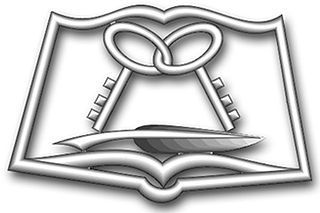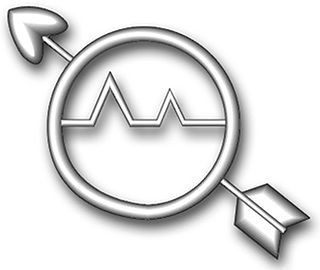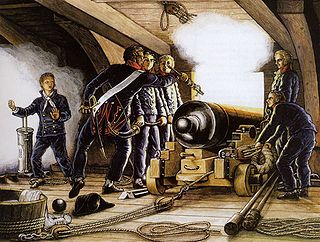A midshipman is an officer of the lowest rank, in the Royal Navy, United States Navy, and many Commonwealth navies. Commonwealth countries which use the rank include Canada, Australia, Bangladesh, Namibia, New Zealand, South Africa, India, Pakistan, Singapore, Sri Lanka, and Kenya.

In a navy, a rate, rating or bluejacket is a junior enlisted sailor who is not a warrant officer or commissioned officer. Depending on the country and navy that uses it, the exact term and the range of ranks that it refers to may vary.

The United States Merchant Marine is composed of United States civilian mariners and U.S. civilian and federally owned merchant vessels. Both the civilian mariners and the merchant vessels are managed by a combination of the government and private sectors, and engage in commerce or transportation of goods and services in and out of the navigable waters of the United States. The Merchant Marine primarily transports domestic and international cargo and passengers during peacetime, and operate and maintain deep-sea merchant ships, tugboats, towboats, ferries, dredges, excursion vessels, charter boats and other waterborne craft on the oceans, the Great Lakes, rivers, canals, harbors, and other waterways. In times of war, the Merchant Marine can be an auxiliary to the United States Navy, and can be called upon to deliver military personnel and materiel for the military.

Hardtack is a type of dense biscuit or cracker made from flour, water, and sometimes salt. Hardtack is inexpensive and long-lasting. It is used for sustenance in the absence of perishable foods, commonly during long sea voyages, land migrations, and military campaigns. Along with salt pork, hardtack was a standard ration for many militaries and navies from the 17th through the early 20th centuries.

Grog is a term used for a variety of alcoholic beverages. The word originally referred to rum diluted with water, which Edward Vernon introduced into the British naval squadron he commanded in the West Indies on 21 August 1740. Vernon wore a coat of grogram cloth and was nicknamed Old Grogram or Old Grog. The Merriam–Webster Collegiate Dictionary, which agrees with this story of the word's origin, states that the word grog was first used in this sense in 1770, though other sources cite 1749. In modern times, the term grog has had a variety of meanings in a number of different cultures, but is commonly used in Australia and New Zealand where it is a slang word for alcohol. In north German culture, Grog is a "classic winter drink from East Frisia" made of rum, sugar and water and heated to boiling point. In Swedish, a "grogg" means a highball drink.
A petty officer (PO) is a non-commissioned officer in many navies and is given the NATO rank denotation OR-5 or OR-6. In many nations, they are typically equal to a sergeant in comparison to other military branches. Often they may be superior to a seaman, and subordinate to more senior non-commissioned officers, such as a chief petty officers.

Quartermaster is a military term, the meaning of which depends on the country and service. In land armies, a quartermaster is generally a relatively senior soldier who supervises stores or barracks and distributes supplies and provisions. In many navies, a quartermaster is an officer with particular responsibility for steering and signals. The seaman is a non-commissioned officer rank; in some others, it is not a rank but a role related to navigation.

A hospital corpsman is an enlisted medical specialist of the United States Navy, who may also serve in a U.S. Marine Corps unit. The corresponding rating within the United States Coast Guard is health services technician (HS).
Cyril Tawney was an English singer-songwriter and a proponent of the traditional songs of the West of England, as well as traditional and modern maritime songs.
Loblolly boy is the informal name given to the assistants to a ship's surgeon aboard British and American warships during the Age of Sail. The name derives from a porridge traditionally served to sick or injured crew members.

The Union Navy was the United States Navy (USN) during the American Civil War, when it fought the Confederate States Navy (CSN). The term is sometimes used carelessly to include vessels of war used on the rivers of the interior while they were under the control of the United States Army, also called the Union Army.

Culinary specialist is a United States Navy occupational rating. The rating was created on January 15, 2004 from the mess management specialist (MS) rating.

Operations Specialist is a United States Navy and United States Coast Guard occupational rating. It is a sea duty-intensive rating in the Navy while most of Coast Guard OS's are at ashore Command Centers.

A powder boy or powder monkey manned naval artillery guns as a member of a warship's crew, primarily during the Age of Sail. His chief role was to ferry gunpowder from the powder magazine in the ship's hold to the artillery pieces, either in bulk or as cartridges, to minimize the risk of fires and explosions. The function was usually fulfilled by boy seamen of 12 to 14 years of age. Powder monkeys were usually boys or young teens, selected for the job for their speed and height: they were short and could move more easily in the limited space between decks and would also be hidden behind the ship's gunwale, keeping them from being shot by enemy ships' sharpshooters. These powder monkeys held no official naval rank on the ships that they sailed on. Some women and older men also worked as powder monkeys.

The United States Navy (USN) is the maritime service branch of the United States Armed Forces and one of the eight uniformed services of the United States. It is the largest and most powerful navy in the world, with the estimated tonnage of its active battle fleet alone exceeding the next 13 navies combined, including 11 allies or partner nations of the United States as of 2012. It has the highest combined battle fleet tonnage and the world's largest aircraft carrier fleet, with eleven in service, two new carriers under construction, and five other carriers planned. With 336,978 personnel on active duty and 101,583 in the Ready Reserve, the United States Navy is the third largest of the United States military service branches in terms of personnel. It has 290 deployable combat vessels and more than 2,623 operational aircraft as of June 2019.

The lighthouse and naval vessel urban legend describes an encounter between a large naval ship and what at first appears to be another vessel, with which the ship is on a collision course. The naval vessel, usually identified as of the United States Navy or the United Kingdom’s Royal Navy and generally described as a battleship or aircraft carrier, requests that the other ship change course. The other party, generally identified as Canadian or often Irish and occasionally Spanish lighthouse keepers responds that the naval vessel should change course, whereupon the captain of the naval vessel reiterates the demand, identifying himself and the ship he commands and sometimes making threats. This elicits a response worded as "I'm a lighthouse. Your call", a punchline which has become shorthand for the entire anecdote.
Chief Petty Officer (CPO) is the seventh enlisted rank in the United States Navy and U.S. Coast Guard, just above Petty Officer First Class and below Senior Chief Petty Officer. The term "rating" is used to identify enlisted job specialties. In this way, enlisted personnel are segregated into three segments containing different enlisted ranks. Furthermore, rates are broken down into three levels: non-rated members without a designated occupation. Advancement to E-4 and above is dependent on graduating from a specialty school that define what the enlisted is rated for. Petty officers and chief petty officers are part of the rated force and considered extremely knowledgeable about their particular rating. Examples include Culinary Services Chief and Aviation Maintenance Chief. The Chief Petty Officer is the rank. Gunners Mate is a rating. E7 is a pay grade. The term rating is used to identify the career field of a chief petty officer. For example, the title of a chief petty officer in the Master-at-Arms rating would be spoken or spelled out as Master-at-Arms, Chief Petty Officer or Chief Master-at-Arms. The title would be abbreviated MAC. The grade of chief petty officer was established on 1 April 1893 in the United States Navy. The United States Congress first authorized the Coast Guard to use the promotion to Chief Petty Officer on 18 May 1920. Chief petty officer is also the final cadet grade in the United States Naval Sea Cadet Corps.

The rum ration was a daily amount of rum given to sailors on Royal Navy ships. It was abolished in 1970 after concerns that the intake of strong alcohol would lead to unsteady hands when working machinery.














